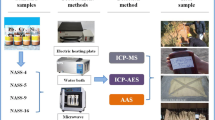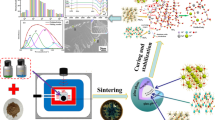Abstract
In this study, we developed a high efficiency sample pretreatment technique using microwave-assisted acid digestion (MAD) under a mixture of HNO3-HCl-HF-H2O2 conditions, capable of leaching various radioactive nuclides from contaminated soil within 2 h. Our validation results using SRM 2709a soil standard material confirmed that when the MAD process was performed and then repeated, the chemical recovery rates of all 9 elements were consistently above 90%, demonstrating an outstanding leaching efficiency compared to conventional acid leaching (AL) methods. The activity of radionuclides obtained through AL were found to be underestimated compared to those obtained through MAD. We anticipate that the application of this technique for precise activity of radionuclides will contribute to cost savings in decommissioning waste management.





Similar content being viewed by others
Data availability
The authors do not have permission to share data.
References
Kim H, Jeon E (2020) Structural changes to nuclear energy industries and the economic effects resulting from energy transition policies in South Korea. Energies 13:1806–1822
EPRI Report (2005) Maine Yankee decommissioning experience report, detailed experiences 1997–2004 Electric Power Research Institute Illinois
IAEA (2008) Managing low radioactivity material from the decommissioning of nuclear facilities. (technical report series no. 462) International atomic energy agency, Vienna
Nuclear Safety and Security Commission (2021) regulations for the waste acceptance of low and intermediate level radioactive waste notice no. 2021–26
Suh K, Yoo JB, Choi K, Kim GY, Oh S, Yoo K, Lee KE, Lee S, Lee YS, Lee H, Kim J, Jung K, Choi S, Park T (2022) Radiochemical analysis of filters used during the decommissioning of research reactors for disposal. J Nucl Fuel Cycle Waste Technol 20:489–500
Lee J, Moon J, Kim G, Lee K (2010) Decontamination of radioactive soil wastes using an agglomeration-leaching process. Korean J Chem Eng 27:639–644
Cao Y, Zhou L, Ren H, Zou H (2022) Decontamination, separation and application of 137Cs: a review. Int J Environ Res Public Health 19:10183–10197
Sanchez-Cabeza JA, Masqué P, Ani-Ragolta I (1998) 210Pb and 210Po analysis in sediments and soils by microwave acid digestion. J Radioanal Nucl Chem 227:19–22
Jiri J, Petr S, Daniel S (2011) Microwave digestion of hardly dissoluble samples. J Radioanal Nucl Chem 290:637–642
Jiri J, Petr S, Daniel S (2012) Rapid dissolution of biological samples using microwave digestion for determination of radionuclide contamination by liquid scintillation. J Radioanal Nucl Chem 293:223–229
Prabhath Ravi K, Sathyapriya RS, Rao DD (2016) Microwave assisted rapid and improved radiochemical method for the estimation of uranium in leaf samples. J Radioanal Nucl Chem 308:317–322
Kamei A (2016) Determination of trace element abundances in GSJ reference rock samples using lithium metaborate-lithium tetraborate fused solutions and inductively coupled plasma mass spectrometry. Geosci Rept 34:41–49
Uchida S, Tagami K, Tabei K (2005) Comparison of alkaline fusion and acid digestion methods for the determination of rhenium in rock and soil samples by ICP-MS. Anal Chim Acta 535:317–323
Yoo JB, Jung K, Choi K, Choi J, Kim GY, Oh S, An H, Kim J, Jung M (2023) Improvement of 94Nb analytical sensitivity in radioactive dry active waste with sequential chemical separation. J Radioanal Nucl Chem 332:4291–4300
Kathryn JL, Steve JH (1998) Microwave digestion procedures for environmental matrices. Analyst 123:103R-133R
Marc P, Magnaldo A, Vaudano A, Delahaye T, Schaer É (2017) Dissolution of uranium dioxide in nitric acid media: what do we know? EPJ Nuclear Sci Technol 3:1–13
Nuclear Regulatory Commission (2004) Multi-agency radiological laboratory analytical protocols manual (MARLAP). Part II: chapters 13, sample dissolution. NUREG-1576. United States
Zafar IZ, Ansari TM, Ashraf M, Abid MA (2006) Effect of hydrochloric acid on leaching behavior of calcareous phosphorites. Iran J Chem Chem Eng 25:47–57
Hasani M, Khodadadi A, Koleini SMJ, Saeedi AH, Pérez-Pacheco Y, Meléndez AM (2017) Platinum leaching from automotive catalytic converters with aqua regia. J Phys Conf Ser 786:012043–012047
Voňavková I, Prùša F, Kubásek J, Michalcová A, Vojtéch D (2022) Microstructure and mechanical properties of Ti-25Nb-4Ta-8Sn alloy prepared by spark plasma sintering. Materials 15:2158–2168
Wang J, Topham N, Wu C (2011) Determination of silica coating efficiency on metal particles using multiple digestion methods. Talanta 85:2655–2661
Lee CH, Lee MH, Han SH, Ha Y, Song K (2011) Systematic radiochemical separation for the determination of 99Tc, 90Sr, 94Nb, 55Fe and 59,63Ni in low and intermediate radioactive waste samples. J Radioanal Nuclear Chem 288:319–325
Komandin GA, Zaytsev KI, Dolganova IN, Nozdrin VS, Chuchupal SV, Anzin VB, Spektor IE (2022) Quantification of solid-phase chemical reactions using the temperature-dependent terahertz pulsed spectroscopy, sum rule, and Arrhenius theory: thermal decomposition of α-lactose monohydrate. Opt Express 30:9208–9221
Costa LM, Ferreira SLC, Nogueira ARA, Nóbrega JA (2005) Use of factorial design for optimization of microwave-assisted digestion of lubricating oil. J Braz Chem Soc 16:1269–1274
Schulz RK (1965) Soil chemistry of radionuclides. Health Phys 11:1317–1324
Nishita H, Wallace A, Romney EM (1978) Radionuclide uptake by plants, U.S. Nuclear Regulatory Commission, NUREG-CR0336, UCLA, 12-1158
Waite TD, Davis JA, Payne TE, Waychunas GA, Xu N (1994) Uranium (VI) adsorption to ferrihydrite application of a surface complexation model. Geochim Cosmochim Acta 58:5465–5478
Murakami T, Ohnuki T, Isobe H, Sato T (1997) Mobility of uranium during weathering. Am Mineral 82:888–899
American National Standards Institute (1999) American national standard for calibration and use of germanium spectrometers for the measurement of gamma-ray emission rates of radionuclides, ANSI N42.14-1999
Martín Sánchez A, Sáenz García G, Jurado Vargas M (2009) Study of self-absorption for the determination of gross alpha and beta activities in water and soil samples. Appl Radiat Isot 67:817–820
Sophie P, Lynn CF, Michael RM, Michael JM, Jason SL (2018) α-emitters for radiotherapy: from basic radiochemistry to clinical studies—part 1. J Nucl Med 59:878–884
Acknowledgements
This work was supported by the Nuclear Power Plant Decommissioning Technology Development Program (Project No. 77873-24) of the Korea Institute of Energy Technology Evaluation and Planning (KETEP). Radioactivity assessments were supported by the KAERI Institutional Program (Project No. 522320-24).
Author information
Authors and Affiliations
Corresponding author
Ethics declarations
Conflict of interest
We declare that we have no known competing financial interests or personal relationships that could have appeared to influence the work reported in this paper.
Additional information
Publisher's Note
Springer Nature remains neutral with regard to jurisdictional claims in published maps and institutional affiliations.
Rights and permissions
Springer Nature or its licensor (e.g. a society or other partner) holds exclusive rights to this article under a publishing agreement with the author(s) or other rightsholder(s); author self-archiving of the accepted manuscript version of this article is solely governed by the terms of such publishing agreement and applicable law.
About this article
Cite this article
Yoo, J.B., Choi, KS., Choi, JW. et al. Microwave-assisted acid digestion (MAD) for the determination of radionuclides in contaminated soil. J Radioanal Nucl Chem (2024). https://doi.org/10.1007/s10967-024-09564-w
Received:
Accepted:
Published:
DOI: https://doi.org/10.1007/s10967-024-09564-w




